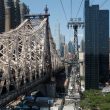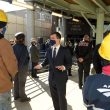Federal traffic strategy seeks to make roadways safer through updated standards, reduced speed limits
Seeking to curb the unprecedented spike in roadway deaths documented over the past several years, the federal government is taking action.
The U.S. Department of Transportation Secretary announced Tuesday a comprehensive new strategy, the National Roadway Safety Strategy, as a roadmap for addressing a “national crisis in roadway fatalities and serious injuries,” a statement about the strategy says.
“Almost 95 percent of our Nation’s transportation deaths occur on America’s streets, roads and highways, and they are on the rise. An estimated 38,680 people died in motor vehicle crashes in 2020. In the first half of 2021, an estimated 20,160 people died, up 18.4 percent compared to the first six months of 2020,” wrote Transportation Sec. Pete Buttigieg in the strategy’s introduction. “The status quo is unnacceptable, and it is preventable. We know it’s preventable because bold cities in the United States, and countries abroad, have achieved tremendous reductions in roadway deaths. We cannot accept such terrible losses here.”
The U.S. Department of Transportation’s National Highway Traffic Safety Administration released its traffic fataility estimates Monday for the first nine months of last year. The organization estimates 31,720 people died in motor vehicle accidents from January through September—an increase of 12 percent over the same period in 2020. That’s the highest year-over-year percentage increase for the first nine months in the Fatality Analysis Reporting System’s history.
Among steps the strategy outlines, the federal government commits to working with state and local road owners to make new and existing roadways safer. Those efforts include updates to the Manual on Uniform Traffic Control Devices, a document specifying standards that traffic signs, markings and signals are designed, installed and used; a Complete Streets Initiative that will provide technical assistance; and revamping speed limits.
Other initiatives include rulemaking on automatic emergency praking and updates to the New Car Assessment Program, a standard overseen by the National Highway Traffic Safety Administration. It’s the first step toward a longterm goal of no traffic-related deaths.
In a statement, the National League of Cities (NLC) applauded the strategy, highlighting the connection between federal and local organizations as a positive step.
While the strategy and its encompassing initiatives represents a new step for the federal government, many individual municipalities have already implemented traffic safety measures that are featured in the measure—with success. Minneapolis and St. Paul, Minn.; Denver; San Francisco; and Charlotte, N.C., have lowered speed limits within city limits, for example.
And Seattle recently announced it will “deprioritize low-risk public safety violations, including biking without a helmet and expired/missing vehicle registrations. These will no longer serve as primary reasons to make traffic stops. A new policy in Colorado will require transportation projects to measure climate impacts and incentivize funding for green mobility options, such as transit, walking and biking.
“City leaders know focusing on safer streets can save lives, decrease traffic crashes and ensure that every one of our residents makes it home safely. I encourage all our local leaders to join us in the Safety First Challenge because together we can save lives and make our streets safer,” said Vince Williams, president of NLC and mayor of Union City, Ga.
Much of the funding to reach each step of the endeavor will come through the Bipartisan Infrastructure Law, which sets aside $6 billion for a new Safe Streets and Roads for All program, hundreds of millions for behavioral research and interventions, and an additional $4 billion for the Highway Safety Improvement Program.
Satya Rhodes-Conway, mayor of Madison, Wisc., called the strategy “a comprehensive approach to transportation safety.”
Beyond roadway safety, Lynne Robinson, mayor of Bellevue, Wash., said the effort will, as a byproduct, “have far-reaching consequences. It will encourage more people to walk and bicycle, enhancing their well-being, and positively impact the environment. We look forward to working with the USDOT to improve safety for everyone.”




















